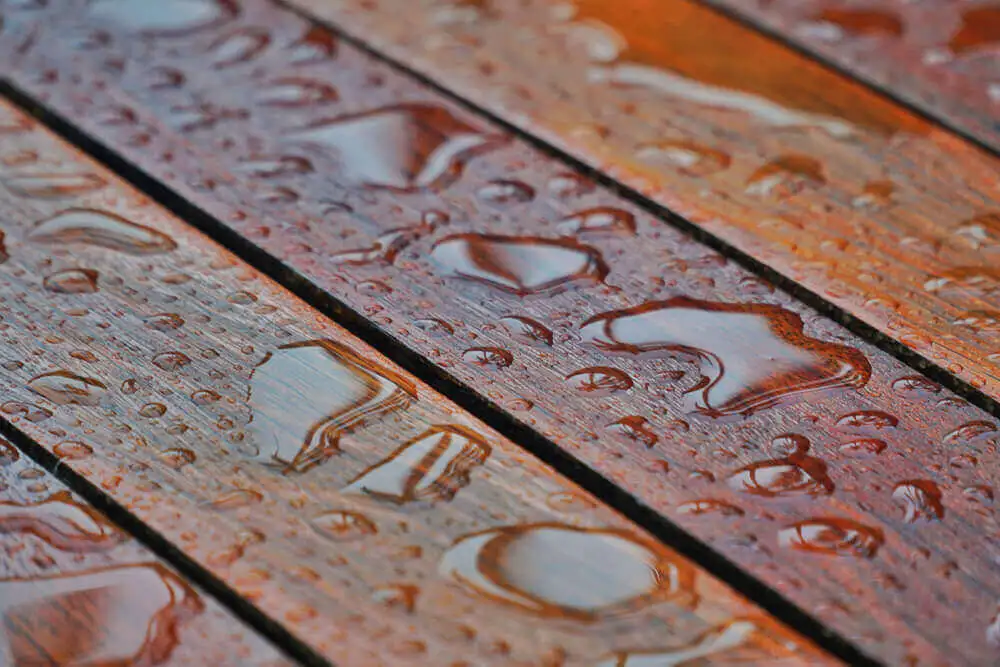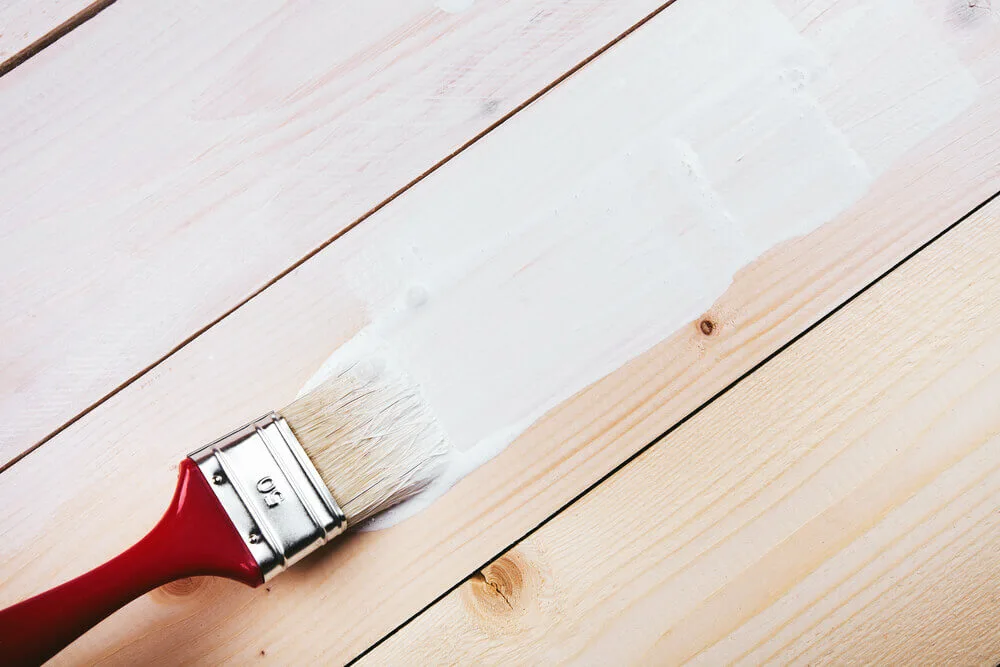Can You Paint Wet Wood – Expert Tips and Techniques
Painting is a fun and creative way to give new life to wood surfaces. However, moisture in the wood can make painting a challenging puzzle. So, can you paint wet wood? The truth is, it’s not recommended, but with the right know-how and tools, it is possible to achieve satisfactory results. In this blog, I’ll cover the risks of painting damp wood, how to properly dry wood, the best paint types for damp wood, and more.
You can paint on damp wood. However, it is not advised. You may still produce a high-quality finished product by utilizing suitable materials and a few techniques to speed up the drying process. Before creating the initial paint brush stroke, you should carefully analyze each.

How to Paint Wet Wood
Painting wet wood is not ideal, but sometimes it’s necessary, especially in humid conditions or when you don’t have the time to wait for the wood to dry completely. To paint wet wood, follow these steps:
- Remove excess water: Use a towel, paper towel, or napkin to blot any visible water beads from the surface of the wood.
- Improve airflow and heat: To promote evaporation, place a fan or heating, ventilation, and air conditioning (HVAC) system near the wood.
- Apply a waterproofing solution: Waterproofing solutions, available at your local hardware store, can help seal and protect the wood from moisture damage.
- Choose the right paint: Opt for latex or acrylic paint, as they work better on damp surfaces than oil-based paints.
- Use a suitable paintbrush: Select a paintbrush with synthetic fibers, as they hold up better in moist conditions.
- Apply paint in thin layers: Thin layers of paint will dry faster, reducing the risk of moisture-related issues.

Risks of Painting Damp Wood and How to Properly Dry Wood
Painting damp wood can lead to several problems, including:
- Peeling paint: Moisture can cause the paint to peel or crack as it dries.
- Mold and mildew: Excess moisture can encourage mold and mildew growth, which can damage the wood and pose health risks.
- Warping: Water content in the wood can cause it to warp, affecting the overall structure and appearance.

To prevent these issues, it’s crucial to properly dry the wood before painting. Here’s how:
- Increase heat and airflow: Place the wood in a well-ventilated area and use a fan, dehumidifier, or HVAC system to speed up the drying process.
- Use a moisture meter: A moisture meter, available at hardware stores or on Amazon, can help determine if the wood is dry enough for painting.
- Wait for the right conditions: If possible, wait for a low-humidity day to paint, as high humidity can slow down the drying process.
How Long Should You Let Wood Dry Before Painting It?
The drying time for wood depends on factors such as the type of wood (hardwood or softwood), the initial water content, and the surrounding environment. As a general rule, it’s best to let wood dry for at least 24 hours before painting. In my experience, this can vary depending on the specific conditions. Using a moisture meter can help you determine when the wood is ready for painting.

How to Dry Wet Wood Before Painting
To dry wet wood effectively, follow these steps:
- Remove surface moisture: Use a towel or paper towel to blot away any visible water from the wood’s surface.
- Create a controlled environment: Move the wood to a dry, well-ventilated area, preferably indoors, away from direct sunlight and rain.
- Use a dehumidifier: Set up a dehumidifier in the same room as the wood to remove excess moisture from the air.
- Increase airflow: Use a fan or HVAC system to promote airflow and speed up evaporation.
- Rotate the wood periodically: Turn the wood over every few hours to ensure even drying.
- Monitor the moisture level: Use a moisture meter to check the wood’s moisture content regularly, ensuring it reaches the optimal level for painting.
How to Tell If Wood Is Dry Enough to Paint?
Using a moisture meter is the most reliable way to determine if the wood is dry enough for painting. For most wood types, a moisture content of 12-15% is considered ideal for painting. Hardwoods, like oak or maple, should have a moisture content of around 8-10%, while softwoods, like pine or cedar, should be closer to 12-15%.
What Paint Type Works Best for Damp Wood?
Latex and acrylic paints are the best choices for painting damp wood, as they adhere better to moist surfaces and are more resistant to moisture than oil-based paints. Water-miscible oil paints can also be used, but they may not be as effective in humid conditions. Always read the manufacturer’s recommendations on the paint label to ensure compatibility with damp wood.
How to Dry Wood Properly and Fast
To dry wood quickly and effectively, use a combination of heat, airflow, and dehumidification:
- Set up a controlled environment: Move the wood to a dry, well-ventilated area, away from direct sunlight and rain.
- Use a dehumidifier: A dehumidifier will help remove excess moisture from the air, promoting faster drying.
- Increase airflow: Use a fan or HVAC system to circulate air around the wood, speeding up evaporation.
- Apply heat: Use a space heater or another heat source to increase the temperature, but avoid placing it too close to the wood to prevent warping or damage.
- Monitor moisture levels: Regularly check the wood’s moisture content with a moisture meter to determine when it is dry enough for painting.
Frequently Asked Questions – Can You Paint Wet Wood?
Conclusion
Painting wet wood can be a challenging task, but with the right techniques, tools, and patience, it is possible to achieve satisfactory results. By properly drying the wood, choosing the right paint type, and following expert tips, you can successfully paint damp wood surfaces and give them a fresh, new look. Always remember to prioritize safety and follow the manufacturer’s recommendations when using paint and drying equipment.
Note: If you face any difficulty while painting wet wood, feel free to ask us any time. We are always here to solve your issues.
Additional Resources and Sources:
- Painting Over Wet Surfaces: What Professionals Say: This link is a discussion on PaintTalk, a professional painting forum where experts share their experiences and advice. You can add this link in the section discussing whether it is safe to paint over wet wood, offering readers insights from industry professionals.
- Dealing with Wet Wood in Construction: This Pro Construction Guide article provides information on how to handle wet wood in construction. You can add this link in the section discussing the challenges of painting wet wood and the importance of drying it properly.
- Wood Moisture Content: Guidelines for Painting: This link from PaintSource Network provides guidelines on the appropriate moisture content for wood before painting. You can add this link in the section discussing how to tell if the wood has dried enough for painting.
- The Science of Wood and Moisture: This Popular Woodworking article explains the relationship between wood and moisture. You can add this link in the section discussing how wood absorbs and releases moisture, providing readers with a better understanding of the topic.

